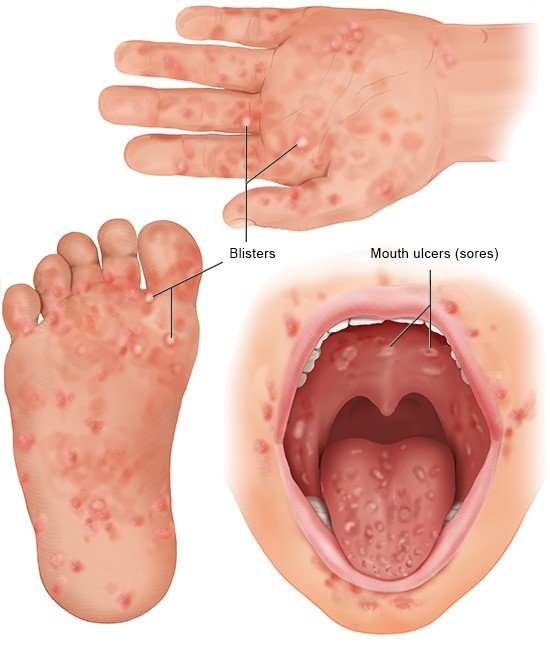Nursing Paper Example on HFMD
Nursing Paper Example on HFMD
Hand, foot, and mouth disease (HFMD) is a contagious viral illness predominantly affecting young children but can occur in individuals of all ages. The condition is caused by enteroviruses, with coxsackievirus A16 and enterovirus 71 being the most common culprits. Characterized by fever, painful sores in the mouth, and a rash on the hands and feet, HFMD is typically mild but may occasionally lead to complications. It spreads through respiratory droplets, direct contact with contaminated surfaces, or fecal matter.

Causes
HFMD is caused by viruses belonging to the Enterovirus genus, primarily coxsackievirus A16 and enterovirus 71. These viruses thrive in the gastrointestinal tract and are highly contagious. Infections are more common in warm climates and during summer and fall.
The disease is spread through close contact, respiratory droplets, and fecal-oral routes, with outbreaks often occurring in schools and childcare settings. Viral shedding in stool can persist for weeks after symptoms resolve, increasing the risk of transmission.
Signs and Symptoms
The incubation period for HFMD is typically three to six days. Early symptoms include fever, sore throat, reduced appetite, and general malaise. Painful ulcers may develop in the mouth, particularly on the tongue, gums, and inner cheeks, leading to difficulty swallowing. A characteristic rash appears on the hands, feet, and sometimes the buttocks, progressing to vesicular lesions.
In some cases, individuals may experience irritability, excessive drooling, or vomiting. Severe cases involving enterovirus 71 can lead to neurological complications such as meningitis, encephalitis, or polio-like paralysis.
Etiology
The etiology of HFMD involves infection with enteroviruses, with different strains causing variations in disease severity. Enterovirus 71 has been associated with more severe cases and complications compared to coxsackievirus A16.
Children under the age of five are most vulnerable due to their developing immune systems and frequent exposure in communal settings. Factors such as poor hygiene, crowded environments, and close physical contact contribute to the rapid spread of the virus.
Pathophysiology
The virus enters the body through the oral or respiratory tract, replicating in the mucosa and lymphoid tissue. From there, it disseminates to the bloodstream, targeting specific organs. The development of oral ulcers and rashes is due to viral replication and immune-mediated responses.
The virus’s affinity for neural and cardiac tissues explains the potential for severe complications, including aseptic meningitis, encephalitis, or myocarditis. Host immune responses, including inflammation and cytokine production, contribute to symptom development and resolution.
(Nursing Paper Example on HFMD)
Diagnosis
HFMD diagnosis is primarily clinical, based on characteristic symptoms such as fever, oral ulcers, and rash distribution. A detailed history of exposure and symptom onset aids diagnosis. Laboratory confirmation may involve polymerase chain reaction (PCR) testing of throat swabs, stool samples, or vesicular fluid to identify the specific enterovirus. Serological testing is less commonly used but may support diagnosis in complex cases or outbreaks.
Treatment Regimens
There is no specific antiviral treatment for HFMD. Management focuses on symptom relief and supportive care. Over-the-counter pain relievers such as acetaminophen or ibuprofen alleviate fever and discomfort. Topical oral gels or rinses can reduce pain from mouth sores.
Maintaining hydration is crucial, as painful swallowing may lead to reduced fluid intake. Severe cases with complications like meningitis or encephalitis may require hospitalization, intravenous fluids, or antiviral therapy under specific circumstances. Strict hygiene practices help prevent further transmission.
Patient Education
Patient education is vital in controlling the spread and managing HFMD. Caregivers should be informed about the importance of handwashing, disinfecting surfaces, and avoiding close contact during active illness. Children with HFMD should stay home from school or daycare until fever resolves and sores heal.
Encouraging hydration and soft, cool foods minimizes discomfort from mouth sores. Parents should seek medical attention if symptoms worsen or neurological signs such as confusion, neck stiffness, or seizures develop.
(Nursing Paper Example on HFMD)
Prevention
Preventive measures include maintaining good hygiene, avoiding close contact with infected individuals, and frequent cleaning of shared surfaces. In outbreak settings, public health interventions like temporary closures of childcare facilities or schools may be necessary.
Vaccination programs targeting enterovirus 71 have been implemented in some countries, reducing severe HFMD cases.
Conclusion
Hand, foot, and mouth disease is a common but usually mild illness that predominantly affects young children. While most cases resolve without complications, severe forms can lead to life-threatening neurological or cardiac issues. Prompt diagnosis, supportive care, and public health measures are essential in managing HFMD and preventing outbreaks. Ongoing research into vaccines and antiviral therapies offers hope for improved prevention and treatment strategies in the future.
References
American Academy of Pediatrics. (2022). Hand, foot, and mouth disease clinical guidelines. Pediatrics Journal. https://www.aap.org
Xu, W., & Liu, C. (2021). Epidemiology of hand, foot, and mouth disease in Asia. Infectious Disease Reports. https://www.infectiousdiseasereports.org
Shen, L., & Ma, H. (2020). Pathogenesis of severe HFMD caused by enterovirus 71. Virology Journal. https://www.virologyjournal.com
Centers for Disease Control and Prevention. (2023). Hand, foot, and mouth disease overview. https://www.cdc.gov
World Health Organization. (2023). Prevention of hand, foot, and mouth disease in community settings. https://www.who.int



